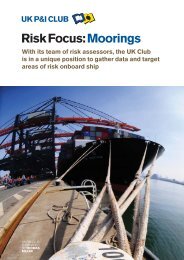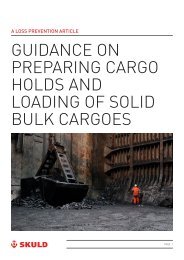You also want an ePaper? Increase the reach of your titles
YUMPU automatically turns print PDFs into web optimized ePapers that Google loves.
<strong>ECSA</strong><br />
<strong>The</strong> <strong>Tramp</strong> <strong>Shipping</strong> <strong><strong>Mar</strong>ket</strong><br />
9.1 Negotiating & concluding a freight contract<br />
When a ship is chartered or a freight rate is agreed, the ship is said to be `fixed'. Fixtures are<br />
arranged in much the same way as any major international hiring or subcontracting operation.<br />
Shipowners have vessels for hire, charterers have cargo to transport, and brokers puts the deal<br />
together. Let us briefly consider the part played by each of these:<br />
<strong>The</strong> shipowner comes to the market with a ship available, free of cargo. For example, it may be a<br />
Panamax bulk carrier currently on a voyage from the US Gulf to deliver grain to Japan, so it will<br />
be `open' (available for hire) in Japan from the anticipated date at which the grain has been<br />
discharged, say 12 May.<br />
<strong>The</strong> shipper has a volume of cargo to transport from one location to another. <strong>The</strong> quantity, timing<br />
and physical characteristics of the cargo will determine the type of shipping contract required. For<br />
example, the shipper may have a cargo of 70,000 tons of coal to ship from Banjamarsin,<br />
Indonesia to Rotterdam. Such a cargo might be very attractive to a bulk carrier operator<br />
discharging coal in Northern China and looking for a cargo to reposition into the North Atlantic,<br />
because he has only a short ballast leg from China to Indonesia and then a full cargo back to<br />
Europe.<br />
Most often the principal (i.e. the shipowner or charterer) will appoint a shipbroker to act for him.<br />
<strong>The</strong> broker's task is to discover what cargoes or ships are available; what the owners/ charterers<br />
want to be paid; and what is reasonable given the state of the market. With this information they<br />
negotiate the deal for their client, often in tense competition with other brokers. Brokers provide<br />
other services including post fixture processing, dealing with disputes, and providing accounting<br />
services in respect of freight, other payments and receipts under the charter, etc. Some owners or<br />
shippers carry out these tasks themselves. However, this requires a staff and management<br />
structure which only very large companies can justify. Since broking is all about information,<br />
brokers tend to gather in shipping centres. London remains the biggest, with other major centres<br />
in New York, Tokyo, Hong Kong, Singapore, Piraeus, Oslo, Hamburg, Copenhagen, Bergen etc.<br />
Three types of contractual arrangement are commonly used. Under a voyage charter, the<br />
shipowner contracts to carry a specific cargo in a specific ship for a negotiated price per ton.<br />
Variants on the theme are the consecutive voyage charter and the contract of affreightment, in<br />
which the shipowner contracts to carry regular tonnages of cargo for an agreed price per ton.<br />
9.2 <strong>The</strong> voyage charter<br />
A voyage charter provides transport for a specific cargo from port A to port B for a fixed price<br />
per ton, so in this case the shipowner pays all the costs relating to the ship. For example, a grain<br />
trader may have 49,000 tons of grain to transport from Mobile in the US Gulf to Chiba in Japan.<br />
So what does he do? He calls his broker and tells him that he needs transport for the cargo. <strong>The</strong><br />
broker will `fix' (i.e. charter) a ship for the voyage at a negotiated freight rate per ton of cargo,<br />
e.g. $25.20. <strong>The</strong> terms will be set out in a charter-party and, if all goes well, the ship arrives on<br />
the due date, loads the cargo, transports it to Chiba, discharges and the transaction is complete.<br />
If the voyage is not completed within the terms of charter-party then there will be a claim. For<br />
example, if laytime (i.e. port time) at Chiba is specified at seven days and the time counted in port<br />
is ten days, the owner submits a claim for three days demurrage to the charterer. Conversely, if<br />
the ship spends only five days in port, the charterer will submit a claim for two days despatch to<br />
the owner. <strong>The</strong> rates for demurrage and despatch are stated in dollars per day in the charter-party.<br />
9.3 <strong>The</strong> Consecutive Voyage Charter (CVC)<br />
A Consecutive Voyage Charter is similar to a Voyage Charter, but the ship is contracted to<br />
undertake a series of cargo carrying voyages on a defined route. This is used when the shipper<br />
Clarkson Research Services Limited 28 <strong>Mar</strong>ch <strong>2015</strong>




